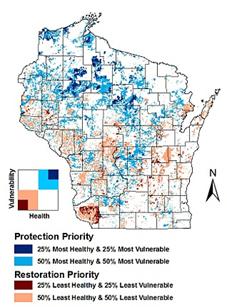Developing a Watershed Vulnerability Index
Because watershed health is a dynamic property that can vary with future changes in climate and human activity, a watershed assessment also evaluates the vulnerability of watershed health to future degradation. Generally, sets of indicators are selected to measure and compile the sub-indices of vulnerability that are most relevant to the watersheds being assessed. Then, a single vulnerability index is developed by aggregating these sub-indices, which may characterize potential risks such as future climate, land use, water use change and wildfire risk. On this web page, we use climate change as an example.
- watershed exposure,
- sensitivity, and
- adaptive capacity to cope with changes.
Whereas projected climate change, for example, may provide information on relative exposure to stress for watersheds across a state, the sensitivity of those watersheds to such changes is generally unknown. However, many efforts around the nation are underway to model the expected hydrologic response of the greater landscape to future changes in climate (e.g., changes in baseflow, surface runoff, and snowpack). Finally, the adaptive capacity of a watershed to cope with such changes is enhanced by connectivity of habitats and maintenance of floodplain, wetland and other landscape features in their natural conditions to support natural hydrology and sediment supply.
- warmer ambient air temperatures,
- earlier and more rapid snowmelt,
- fewer and more intense rainfall events, and
- more frequent and extreme droughts and floods.
- reduced dissolved oxygen levels in streams and lakes,
- loss of:
- habitat for cold and cool water fish species,
- wetlands and reduced riparian/floodplain connectivity,
- upstream/downstream connectivity due to drying of stream and river reaches,
- reduced extent, diversity and quality of instream habitat for aquatic biota, and
- increased pollutant concentrations from urban and agricultural runoff.
- Maintenance of baseflow during periods of drought
- Flood mitigation as a result of:
- Natural stormwater infiltration
- Floodplain connectivity
- Natural surface- and groundwater hydraulic storage
- Air and water temperature regulation associated with:
- Native forested and riparian vegetative shading
- Evapotranspiration
- Riparian and stream habitat corridors for species migration to more suitable environments
- Carbon sequestration in native flora and soils
 The large-scale systems approach to watershed health assessment and protection promoted by the EPA Healthy Watersheds Program can be a key element of a climate change adaptation strategy. Protecting the adaptive features of healthy watersheds, such as:
The large-scale systems approach to watershed health assessment and protection promoted by the EPA Healthy Watersheds Program can be a key element of a climate change adaptation strategy. Protecting the adaptive features of healthy watersheds, such as:- meander belts,
- riparian wetlands,
- floodplains,
- terraces,
- sediment transfer areas,
- water storage and nutrient cycling capabilities,
- natural hydrologic regimes, and
- riparian corridors ,
will help maintain system resiliency to climate change. Collaboration across agencies, organizations and jurisdictional boundaries is an important element of both implementing healthy watershed protection strategies and climate adaptation plans.
The Wisconsin Integrated Assessment of Watershed Health Exitprovides an example of how climate change can be factored into statewide watershed health assessment and protection. In addition to characterizing present-day landscape, habitat, geomorphology, hydrology, water quality and biological condition, the assessment also used projections of climate-driven changes in runoff and water quality to characterize vulnerability of aquatic ecosystems to future climate change. In order to prioritize its watershed protection efforts, the Wisconsin Department of Natural Resources is using watershed health and vulnerability data to explore watersheds that are presently healthy but vulnerable to future degradation.
Examples of State Climate Change Adaptation Plans
Below are examples of state climate change adaptation plans that recognize protection of healthy watersheds as an integral component of adaptation planning.
The following links exit the site Exit
- Oregon Climate Adaptation Framework (PDF) (151 pp, 567 K)
- New Hampshire Climate Action Plan
- California Climate Adaptation Strategy
- Pennsylvania Climate Adaptation Planning (PDF)
- Wisconsin’s Changing Climate: Impacts and Adaptation
- Preparing for a Changing Climate – Washington State’s Integrated Climate Response Strategy(PDF). (463 pp, 8.46 MB)
- Toward a Resilient Watershed - Addressing Climate Change Planning in Watershed Assessments (Oregon)(PDF) (151 pp, 1.7 MB)
Related Resources
- Climate Change (EPA)
- Climate Change and Water (EPA)
- Scanning the Conservation Horizon
- Climate Wizard Exit
- Incorporating Climate Change Adaptation into State Wildlife Action Plans (50 pp, 4.5 MB) Exit
- U.S. Forest Service Rocky Mountain Research Station Climate-Aquatics Blog
- GlobalChange.gov (U.S. Global Change Research Program): Impacts of Climate Change on Biodiversity, Ecosystems and Ecosystem Services (PDF) (296 pp, 5.6 MB)
- Aquatic Ecosystems and Climate Change (56 pp, 363 K) Exit
